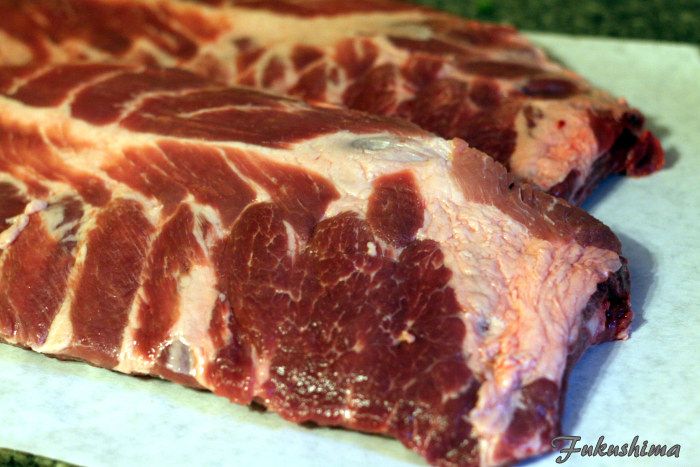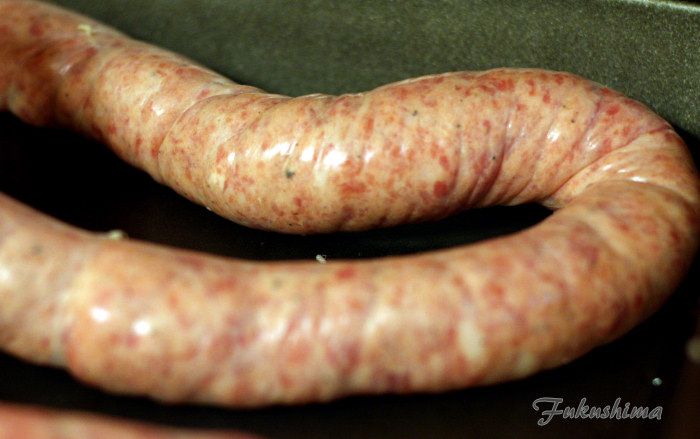Cooker of choice: The NorCal Brethren UDS
Fuel: Royal Oak lump charcoal
Wood: Pecan and Apple chunks
Temperature: 300°F
The meat was two racks of spareribs that I got from my local carneceria, decided to give this place a try, as I figured it would not be worse than Safeway, and might well be better. And because I ended up having to sit around at the courthouse for jury duty, I was not able to hit my usual restaurant supply place. This was some great pork, quality was excellent, and at around $3 a pound, priced like spareribs and not pork loin.
Trimmed and Ready
Gave them what I know as a modified St. Louis cut, I have heard this called a Kansas City cut rib as well. Essentially, the flap of meat and membrane under the bones are removed, the tips are cleaned up, the surface fat is removed and if there is any chest bone, it is removed.
Chest Bones, never on Cryo-vac ribs
The rub was a Maple and Pepper rub, which was applied in two layers, one was a medium layer, as seen in the photos below, the second was a dusting, more on that later.
Maple and Black Pepper Rub:
5 parts maple sugar
3 parts medium grind black pepper
2 parts Kosher salt (I use Redmond RealSalt)
1 part smoked Spanish paprika
1/2 part each granulated garlic, and granulated onion
1/4 part Allspice
Made one and a half batches of this stuff, used one as it was, for layer one of the rub. This was sprinkled and patted onto the meat and left to melt for one hour (I use that time to get the cooker fired up).
Medium coating, could be more even I suppose
Or not, should be fine
Once things were ready in the cooker, the ribs went on, and were left to run, flat on the rack for 2 hours, then I put them over a pan, and onto a rack, with the fatter ends up, this encourages a little higher heat on the tip ends, which gets the cook more even. The second layer of rub, that was the half a recipe of the rub that I had made, which I ran through the mortar and pestle, to grind it into a powder. Fine powder. This was then used in conjunction with my Pig Honey spritz, first the Pig Honey was spritzed onto the meat, then a layer of the powdered rub was sprinkled over. This was done when I moved the meat to the rack. Another coating of the Pig Honey was applied about 15 minutes before I moved the whole thing into the oven.
Here they are on the rack
I ended up bringing the ribs in at this point, and putting them into the oven at 225°F for another hour. They actually were very close to being done, and I could have let them go in the UDS, but, I wanted to control the last two hours, and it was dark outside. I cheated. 225°F for one hour, then off for another 2 hours, while I was in bed reading. I foiled and tossed them into the refrigerator, wrapped in foil for reheating the next morning. Started at 3:30 p.m. was in bed by 11:00 p.m. Not too bad.
Tossed them, still wrapped for 40 minutes at 225°F this morning, then unwrapped for 20 minutes at 245°F unwrapped. Got this.
Looking good so far
From here, they were packaged up in a pan and taken to their final destination, waited for around 30 minutes for serving, still hot and looked like this.
Nice Texture
Nice bark too
All in all, a very successful cook, the ribs were moist and tender, not fall off the bone, but, just short of that. The overall flavor and texture were about as good as I would expect from myself. I would never turn in full spares for a competition, but, the flavor and texture of these ribs were good enough for just that.



























